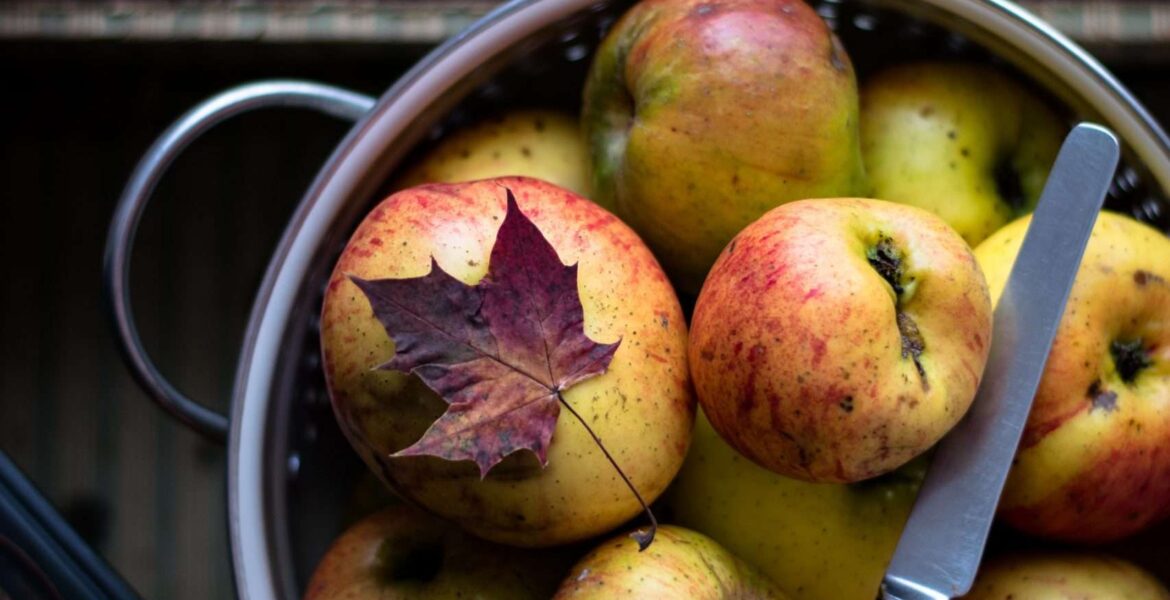The Magic Of Apples: How To Make Apple Pie GF

Fall and apples go hand in hand. As a result, I look forward to the many varieties available locally when late August rolls around. Apples are juicy, tasty, and chock full of nutrition and health-promoting substances. One of apple’s claims to fame: the most common fruit throughout the world. Furthermore, many enjoy the traditional dessert but want to learn how to make apple pie gluten-free.
While I like to focus on foods in their whole state being what best nourishes the body in both healing and prevention of disease, let’s do the reductionist thing and pick apart the nourishing graces of good ‘ole apples. Just for fun!
Apples Nourishing Graces
Apples are high in complex carbohydrates; an excellent source of pectin. Pectin is a soluble fiber, meaning it dissolves into a gel-like substance. Comparing soluble fiber to the insoluble fibers of vegetables and the bran in whole grains, insoluble fibers do not break down but create a scouring bulk in the intestines. The fiber in foods contributes to the complex world of micro-organisms in our guts, hence keeping the microbial balance beneficial to our health and supporting our colon functioning efficiently. As the saying goes, An Apple A Day…
Raw apples have a complex of minerals, vitamins A-B-C, and contain phytonutrients and antioxidants. As far as protein and fat go, don’t look to apples to contribute much to your diet.
Ayurvedic Properties Of Apples
Apples can be looked at through the lens of traditional medical practices, Ayurvedic and Chinese Medicine as two examples, and how apple’s qualities affect the body’s functioning and healing capacities. Consequently, they are considered a cooling food (cools the body’s energy) with effects on the meridians that impact the energy of our digestive system. Apples are a juicy, moistening food and have been prescribed to impact hot and dry conditions in the body: fever, thirst, dry cough, “hot” diarrhea, liver conditions, and gall stones (especially the use of real apple cider vinegar for gall stones). Apples have also been noted to work well against stomach flu viruses.
Despite there being over 7000 varieties of apples on this Earth of ours, the standard US apple crop is less than 30 varieties. The move towards more organic and heritage varieties of produce has created a rise in the growth and production of more apple varieties in the US. In fact, this is a plus for all of us and an invitation to explore new varieties of apples.
Check out this page, on the pick your own website, as it showcases a chart on apple varieties, their characteristics, and where the apple variety ranks in regards to raw eating or cooking use: https://pickyourown.org/applevarietiestochoose.htm.
Meanwhile, click around the website to discover orchards all over NYS.

How To Make Apple Pie
Apple pie is probably my favorite pie. I have worked with making whole-food crusts and gluten-free crusts for years, decades now. For those of you missing out on pies because of gluten intolerances, I suggest you pop into the kitchen and try making a gluten-free pie crust.
Making The Whole Grain Gluten-Free Pie Crust
Look for all ingredients on the shelves and in the coolers at the Potsdam Food Co-op.
- 1/3 cup butter, although from pasture-raised cows is preferable
- 1 cup organic, whole grain, gluten-free flour*
- 1/4 tsp. unrefined sea salt
- 1 – 2 tbsp. cold water or organic milk
When making a whole grain pie crust, I have found it much easier to make it in a food processor. The pie dough melds together really well and rolls out nicely. I have tried many methods: fork, fork and knife, pie pastry hand blender, etc. For this reason, the best whole grain pie crust, for me, is made in a food processor.
First, I put in the flour, sprinkle the salt in, add butter in cold slices, and put the lid on. Second, turn the food processor on and drizzle the water or milk in through the top. Finally, when the dough balls up and is rolling about inside the canister, shut off the processor.
Rolling Out The Pie Dough
To roll the dough I sprinkle a bit of oat or cassava root flour onto my pastry cloth and use a cotton pie sleeve on my rolling-pin. I bought my cloth pie making set at Evan’s & White’s Hardware store, Potsdam.
Roll out the pie dough and put it into the pie plate. Both whole grain and gluten-free pie crusts can be tough to handle without tearing. I just piece it back together. A perfectly flawless pie crust is not necessary to be tasty.
I make a second crust batch for the top crust. I have found it works best, for me, to make one crust batch at a time in the food processor. If I am going to make a lattice top I just make a little extra dough in one batch. Approximately 1 1/3 cup flour plus maybe an extra tbsp., 1/2 cup butter, 1/4 tsp. salt, and 2 tbsp. cold milk.
Apple Pie Filling
- 6-8 organic apples, the number needed depends on the apple sizes. Having a nice rounded mound in your pie plate, before adding the top crust, is ideal for a well-stuffed apple pie.
- Slice into thin pieces. I leave the nutritious, fiber-rich peels intact on the apples. You do what you like with the peels.
- 1/2 cup unrefined sucanat brown sugar
- 1 tsp. organic Ceylon cinnamon
- 1 1/2 tsp. organic vanilla
- Oat or cassava root flour, say 1/4 cup, to thicken the apple juice so the pie is not runny.
Mix apples slices with the rest of ingredients.
Fill pie crust and top with 2nd crust or a lattice top. I usually brush the top with milk before cooking. Some people like to sprinkle it with a bit of the sucanat sugar as well.
Pop into the oven and bake for approximately 50 to 60 minutes at 350 F. Apples should be gently bubbling inside the pie, not running liquid all over the oven.
*Gluten-Free Flour Information:
- I use mostly certified organic – certified gluten-free oat flour in pie crusts. I buy organic, gluten-free oat flakes and grind my own flour.
- The oat flour will make a smooth crust. Other organic, gluten-free whole grains that I have ground for pie crusts can make the crust textured and grainy. I have mixed millet, quinoa, amaranth, buckwheat, and teff with the oat flour. If you are not used to whole grains in pastries, I am just warning you about the fiber feel. Also, buckwheat flour has a strong flavor. I find this flavor very yummy, but again, if you are not used to buckwheat’s flavor, it is a big leap from refined, white flour pie crust pastries. I use buckwheat as about ¼ the total flour amount, mixing with other milder tasting flours.
- When I use these stronger whole grains, I sometimes add a tiny bit of sugar and cinnamon to the pie crust while in the food processor. I would say maybe a tablespoon of the sugar and ¼ tsp. of cinnamon.
- I also use whole ground cassava root flour as a great pie flour option mixed with oat or other whole grain, gluten-free flours.
A whole-grain apple pie is very yummy and full of cell regenerating whole food nourishment and avoids refined flours and sugars that deplete our deep, vital health.
See last week’s post on nourishing the body with whole foods.
3 books for researching the nutritional and healing benefits of whole foods:
- Whole Food Facts by Evelyn Roehl
- The New Whole Foods Encyclopedia by Rebecca Wood
- Heinerman’s Encyclopedia of Fruits, Vegetables, and Herbs by John Heinerman
While I do encourage this pursuit if it is of interest to you, I also like to remind people to trust in the nourishment of whole, organic, local foods to keep your body healthy. The balance of nutrients, in foods grown properly, is just what the body needs to stay healthy, strong, and vital through the years.






